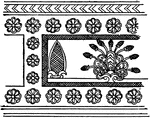Clipart tagged: ‘adornment’

Assyrian Ornament
The purely conventional ornaments — the rosette, guilloche, and lotus-flower, and probably also…

Ear Piece Jewelry
Ornaments, such as bracelets, necklaces, or rings, made of precious metals set with gems or imitation…

Ornament at the foot of the wall from the Great Temple at Philæ
They are generally of smaller dimensions in the interior, so that the walls or columns of the same chamber…
Hat Pin
A decorative pin for holding a hat to the head, usually by the hair. In Western culture, a hatpin is…